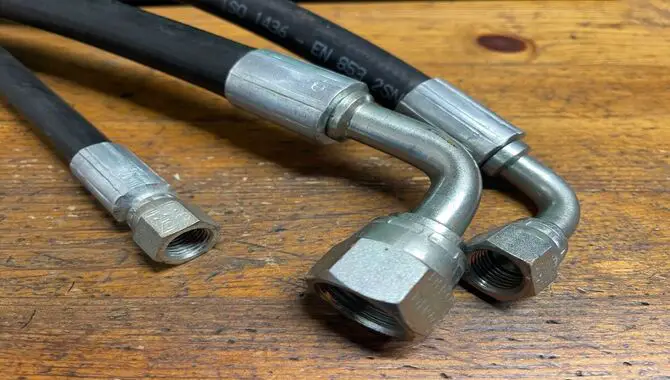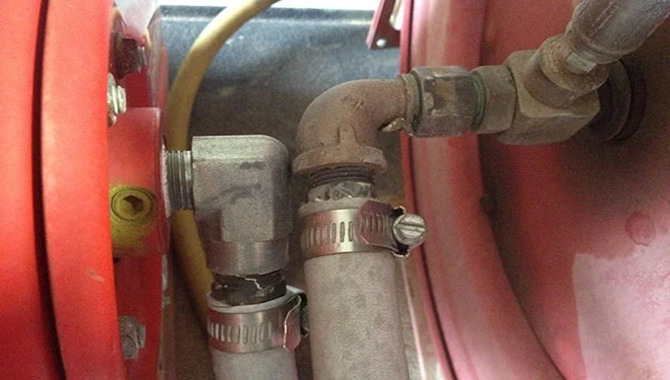Air compressor fittings are an essential component of any compressed air system. They connect the air hose to the tool or machinery and regulate the airflow. Choosing the right air compressor fittings can be overwhelming, especially for those new to using compressed air systems.
However, if you’re in the market for an air compressor. It’s important to understand that you’ll need a variety of fittings to make it work properly. Many different types of air compressor fittings are available, and choosing the right ones can be overwhelming.
Here we will guide you through the process of How to choose the right air compressor fittings for your specific needs. We will cover everything from hose length and size to maximum working pressure and types of air hose. We will also provide tips on how to replace your air hose and when to do so.

How To Choose The Right Air Compressor Fittings – In Details

How to Choose the right air compressor fittings involves considering several essential factors. Make sure that the size and type of your air compressor hose match your chosen fitting, and look . For ones with similar thread sizes to your tools or equipment. Determine the maximum pressure rating needed based on your specific requirements.
And choose between quick-connect or threaded fittings according to your usage and preference. Also, consider durable materials like brass or stainless steel to ensure long-lasting performance. With these considerations in mind, you can select the right fittings for optimal performance of your air tool accessories without any defect.
Hose Length For Your Application

Choosing the right length of the air hose is crucial for optimal performance. When selecting an air hose for your application, remember the distance between your compressor and tools to determine how much hose you need. A shorter hose may suffice if you work close to the compressor, while longer distances require a longer hose.
Also, ensure that the selected air hose can handle your compressor’s maximum air pressure and flow rate. With this knowledge, you can pick an appropriate length of highly durable polyurethane or nylon tubing that ensures easy storage without any defects or abrasion worries.
Hose Size For Your Application

Selecting the right hose size is crucial for optimal performance when using your air compressor. Take into account the type of tool you’ll be using — for example, smaller nail guns work best with a smaller hose size, while larger sanders or spray guns require a larger diameter to deliver enough airflow.
To avoid subpar performance or damage to your power tools, make sure that you select the correct internal diameter and length of your air hose based on its respective specifications and industrial applications.
Maximum Working Pressure For Your Application
To ensure optimal performance and avoid equipment damage, it’s crucial to choose air compressor fittings that can handle the maximum working pressure of various pneumatic tools and accessories. Checking each tool’s manufacturer specifications is essential before deciding on fittings rated for at least the highest required air pressure level.
Leaks and other defects can occur when using connectors with a lower PSI rating than required for high-pressure applications. Always opt for durable and high-pressure-rated couplers/plugs/connectors instead of compromising on cheaper options or risking potential harm to yourself by using faulty ones.
Types Of Air Hose (Standard Or Coiled)

Choosing the right air compressor fittings involves considering various factors, such as the type of hose required for your application. Two primary options include standard and coiled hoses. While standard hoses are made of rubber and are more durable but heavy and less flexible than coiled ones, which makes them ideal for portable or mobile applications.
Ensure that your chosen fittings match your hose’s size to avoid defects in performance or damage to equipment. Pick an appropriate hose based on its internal diameter, abrasion resistance, coils, tubing material (PU/Nylon), connector threading (NPT/PCL), among other factors.
Hose End Fittings For Your Application
Hose end fittings are an essential component when it comes to setting up your air compressor system. You can choose from various types of fittings, including quick connectors, couplers, plugs and adapters.
It is important to consider factors such as the type of application you will be using it for, the working pressure, and the airflow requirements while selecting these fittings. With the right hose end fitting in place, you can increase efficiency and performance while reducing downtime due to defects.
How To Replace Your Air Hose

To ensure a secure connection while replacing your air hose, choose the right size and type of fitting compatible with both the hose and fittings to avoid leaks. Consider different types of fittings, like quick-connect or threaded fittings, based on your application.
Tighten all connections properly to avoid air leaks for maximum efficiency. Regularly inspect and replace any damaged or worn-out couplers, connectors or plugs to maintain optimal performance of your compressor accessories.
When To Replace Your Air Hose?

To ensure the safe and efficient operation of your pneumatic tools and accessories. You must not ignore replacing your air hose on time. The hose may show signs of abrasion or cracking due to constant use and exposure to compressed air pressure.
Check for any defects in the hose by evaluating its compatibility with your air compressor setup’s specifications like tank size, horsepower rating and cubic feet per minute (CFM) delivery rate. Regular inspection can help you identify defects early on. It’s crucial to select the right type of fitting that provides a secure connection between the air tool and the hose.
Choosing The Perfect Air Hose

To choose the right air compressor fittings, evaluate the specifications of your compressor. When selecting an air hose, consider a durable material that can easily handle compressed air flow at high pressure. The hose’s internal diameter should be appropriate to maintain proper airflow volume.
Select couplers and connectors compatible with your chosen accessories and mailers for optimal performance. When selecting an air hose, remember to check for additional features such as kink resistance and easy storage options.
What Length Of Air Hose Do You Need?

The length of air hose you need depends on your working environment and the distance between the compressor and the pneumatic tool or accessory. A longer air hose may be needed for larger workspaces, but remember that a longer hose can also cause a drop in air pressure.
To maintain maximum efficiency, choose a hose length that meets your needs without compromising on airflow volume or pressure. Consider investing in extension hoses if necessary. Always properly store and maintain your air hoses to ensure their longevity and performance.
What Diameter Of Air Hose Do You Need?

The diameter of the air hose needed is determined by the CFM required by the tool you plan to use. Smaller tools like nailers may only require a 1/4-inch hose, while larger tools like sanders or grinders will need a larger hose to maintain proper airflow. Selecting a hose with the appropriate diameter is important to prevent air pressure drops and ensure efficient performance.
Check the manufacturer’s specifications for your tools to determine the required CFM and hose diameter. Remember that a smaller diameter hose can restrict airflow, causing decreased performance and potential damage to your tool over time.
How To Choose The Right Fittings And Connectors

Choosing the right fittings and connectors for your air compressor involves several factors. Begin by ensuring compatibility with your specific air compressor and tools. Opt for durable materials that can withstand high-pressure levels. Check the thread size, shape, and type of fitting required for your application. Also, ensure they are compatible with other accessories in your collection.
Conclusion
How to choose the right air compressor fittings is important steps in ensuring that your air tools work properly and efficiently. By understanding the different types of fittings available and their specific uses, you can decide which ones will best meet your needs.
Some factors to consider include the size and shape of the fitting, the material it’s made from, and its compatibility with your air compressor and tools. You also need to pay attention to the end fittings and connectors that are best suited for your application. Maintaining your air hose is also important to ensure optimal performance and longevity.
Frequently Asked Questions
[rank_math_rich_snippet id=”s-f540d743-99c3-4562-bf9a-782537794a4e”]

I am passionate about home engineering. I specialize in designing, installing, and maintaining heating, ventilation, and air conditioning systems. My goal is to help people stay comfortable in their homes all year long.








